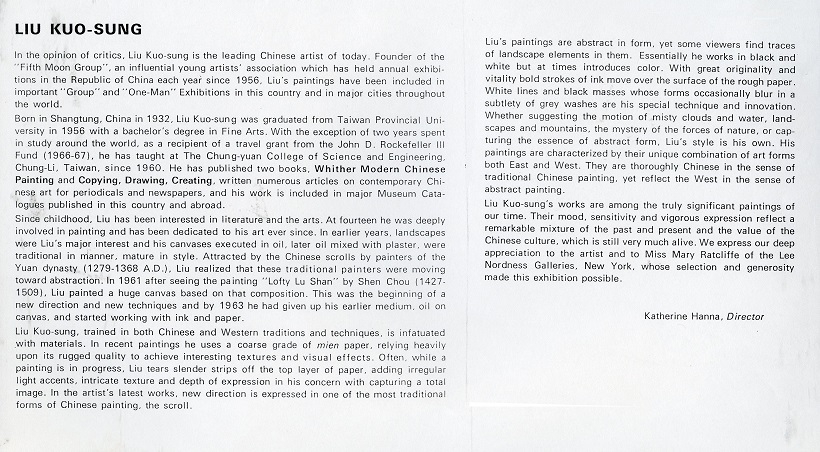LIU KUO-SUNG
- 期刊与书籍
- Katherine Hanna
- 1968.11
In the opinion of critics, Liu Kuo-sung is the leading Chinese artist of today. Founder of the “Fifth Moon Group”, and influential young artists’ association which has held annual exhibitions in the Republic of China each year since 1956, Liu’s paintings have been included in important “Group” and “One-Man” Exhibitions in this country and in major cities throughout the world.
Born in Shangtung, China in 1932, Liu Kuo-sung was graduated from Taiwan Provincial University in 1956 with a bachelor’s degree in Fine Arts. With the exception of two years spent in study around the world, as a recipient of a travel grant from the John D. Rockefeller III Fund (1966-67), he has taught at The Chung-yuan College of Science and Engineering., Chung-Li, Taiwan, since 1960. He has published two books, Whither Modern Chinese Painting and Copying, Drawing, Creating, written numerous articles on contemporary Chinese art for periodicals and newspapers, and his work is included in major Museum Catalogues published in this country and abroad.
Since childhood, Liu has been interested in literature and the arts. At fourteen he was deeply involved in painting and has been dedicated to his art every since. In earlier years, landscapes were Liu’s major interest and his canvases executed in oil, later oil mixed with plaster, were traditional in manner, mature in style. Attracted by the Chinese scrolls by painters of the Yuan dynasty (1279-1368 A.D.), Liu realized that these traditional painters were moving toward abstraction. In 1961 after seeing the painting “Lofty Lu Shan” by Shen Chou (1427-1509), Liu painted a huge canvas based on that composition. This was the beginning of a new direction and new techniques and by 1963 he had given up his earlier medium, oil on canvas, and started working with ink and paper.
Liu Kuo-sung, trained in both Chinese and Western traditions and techniques, is infatuated with materials. In recent paintings he uses a coarse grade of mien paper, relying heavily upon its rugged quality to achieve interesting textures and visual effects. Often, while a painting is in process, Liu tears slender strips off from the top layer of paper, adding irregular light accents, intricate texture and depth of expression in his concern with capturing a total image. In the artist’s latest works, new direction is expressed in one of the most traditional forms of Chinese painting, the scroll.
Liu’s paintings are abstract in form, yet some viewers find traces of landscape elements in them. Essentially he works in black and white but at times introduces color. With great originality and vitality bold strokes of ink move over the surface of the rough paper. White lines and black masses whose forms occasionally blur in a subtlety of grey washes are his special technique and innovation. Whether suggesting the motion of misty clouds and water, the landscapes and mountains, the mystery of the forces of nature, or capturing the essence of abstract form, Liu’s style is his own. His paintings are characterized by their unique combination of art forms both East and West. They are thoroughly Chinese in the sense of traditional Chinese painting, yet reflect the West in the sense of abstract painting.
Liu Kuo-sung’s works are among the truly significant paintings of our time. Their mood, sensitivity and vigorous expression reflect a remarkable mixture of the past and present and the value of the Chinese culture, which is still very much alive. We express our deep appreciation to the artist and to Miss Mary Ratcliffe of the Lee Nordness Galleries, New York, whose selection and generosity made this exhibition possible.
Katherine Hanna, Director
